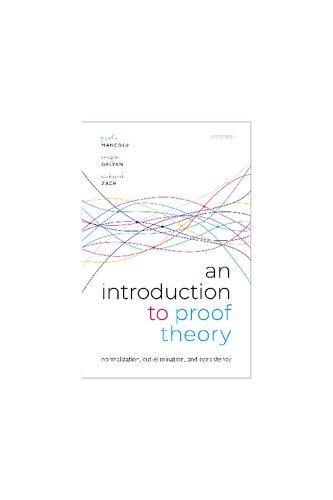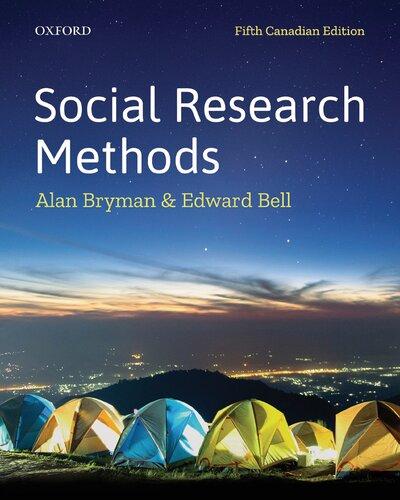An Introduction to Proof Theory: Normalization, CutElimination, and Consistency Proofs 1st Edition Paolo Mancosu
https://ebookmass.com/product/an-introduction-to-proof-theorynormalization-cut-elimination-and-consistency-proofs-1st-editionpaolo-mancosu/
ebookmass.com
The Long Shadow Beth Kanell
https://ebookmass.com/product/the-long-shadow-beth-kanell/
ebookmass.com
Social Research Methods 5th Edition Alan Bryman && Edward Bell
https://ebookmass.com/product/social-research-methods-5th-editionalan-bryman-edward-bell/
ebookmass.com
Letty and the Last Stiff's: A Zombie Apocalypse Reverse Harem Novel (Letty's Zombie Chronicles Book 1) Kitty Siberia
https://ebookmass.com/product/letty-and-the-last-stiffs-a-zombieapocalypse-reverse-harem-novel-lettys-zombie-chronicles-book-1-kittysiberia/
ebookmass.com
The Moonlight Blade Tessa Barbosa
https://ebookmass.com/product/the-moonlight-blade-tessa-barbosa/
ebookmass.com
HowtousetheHandbook Toseek 1. Stabilitydataonsinglespecificcompounds: lookinSection1usingeitherthechemicalnameindex(Appendix4)ortheempirical molecularformulaatrightofsecondtitleline(Carbon;thenHydrogenifpresent;otherelementsfollowalphabetically)tolocatethe page.Membershipofageneralgroupisshownbya Seeother ...cross-reference.
2. Dataonpossibleviolentinteractionbetweentwoormorecompounds: determinewhichappears“morereactive”andfinditasin1 above.Thenlookdownthesubentrytitlesfortheothercompound(s)involvedwhichmaybegivenasasinglecompoundorasoneofa groupThelatterarelistedin Appendix6
3. Generaldataonaclassorgroupofcompounds,orinformationonidentityofindividualsinaknownhazardousgroup: referto theAlphabeticalSection2.Thereisaclassifiedindexin Appendix6
4. Structureassociatedwithexplosiveinstability: See EXPLOSIBILITY
5. Informationongeneraltopics: usetheindexesin Appendix6
6. Fire-relateddata: thisistabulatedin Appendix2
7. InformationonacompoundidentifiedbyitsCASRegistrynumber:thereisanumericalindexofCASnumbers vs Serialnumbers in Appendix5
Donotassumethatlackofinformationmeansthatnohazardexists.Lookfurtheratrelatedstructures,using Appendix6. Seerearendpaperfor Whatthehandbookprovides.
Readersareencouragedtosubmitdetailsofnewreactivehazardsforinclusioninlatereditions.Thereisapageyoucancopyforthis purposeattheendofbook.
ANINDEXEDGUIDETOPUBLISHEDDATA
Bretherick’sHandbookof ReactiveChemical Hazards EighthEdition Editedby PGUrben
Assistedby MJPitt DepartmentofChemicalandBiologicalEngineering UniversityofSheffield
Elsevier Radarweg29,POBox211,1000AEAmsterdam,Netherlands TheBoulevard,LangfordLane,Kidlington,OxfordOX51GB,UnitedKingdom 50HampshireStreet,5thFloor,Cambridge,MA02139,UnitedStates
© 2017ElsevierLtd.Allrightsreserved.
Nopartofthispublicationmaybereproducedortransmittedinanyformorbyanymeans,electronicormechanical,including photocopying,recording,oranyinformationstorageandretrievalsystem,withoutpermissioninwritingfromthepublisher. Detailsonhowtoseekpermission,furtherinformationaboutthePublisher’spermissionspoliciesandourarrangementswith organizationssuchastheCopyrightClearanceCenterandtheCopyrightLicensingAgency,canbefoundatourwebsite: www.elsevier.com/permissions.
ThisbookandtheindividualcontributionscontainedinitareprotectedundercopyrightbythePublisher(otherthanasmaybe notedherein).
Notices
Knowledgeandbestpracticeinthisfieldareconstantlychanging.Asnewresearchandexperiencebroadenourunderstanding, changesinresearchmethods,professionalpractices,ormedicaltreatmentmaybecomenecessary.
Practitionersandresearchersmustalwaysrelyontheirownexperienceandknowledgeinevaluatingandusingany information,methods,compounds,orexperimentsdescribedherein.Inusingsuchinformationormethodstheyshouldbe mindfuloftheirownsafetyandthesafetyofothers,includingpartiesforwhomtheyhaveaprofessionalresponsibility.
Tothefullestextentofthelaw,neitherthePublishernortheauthors,contributors,oreditors,assumeanyliabilityforany injuryand/ordamagetopersonsorpropertyasamatterofproductsliability,negligenceorotherwise,orfromanyuseor operationofanymethods,products,instructions,orideascontainedinthematerialherein.
LibraryofCongressCataloging-in-PublicationData AcatalogrecordforthisbookisavailablefromtheLibraryofCongress
BritishLibraryCataloguing-in-PublicationData AcataloguerecordforthisbookisavailablefromtheBritishLibrary
ISBN:978-0-08-100971-0
ForinformationonallElsevierpublicationsvisitourwebsiteat https://www.elsevier.com/books-and-journals
Publisher: JohnFedor
AcquisitionEditor: KostasMarinakis
EditorialProjectManager: SarahJaneWatson
ProductionProjectManager: PaulPrasadChandramohan
CoverDesigner: MathewLimbert
TypesetbySPiGlobal,India
Introduction THISSHOULDBEREADTHROUGHCAREFULLYTOGAINFULLBENEFITFROMWHATFOLLOWS
AimsoftheHandbook Thiscompilationhasbeenpreparedandrevisedtogiveaccesstoa wideandup-to-dateselectionofdocumentedinformationto researchstudents,practisingchemists,safetyofficersandothers concernedwiththesafehandlinganduseofreactivechemicals. Thiswillallowreadyassessmentofthelikelypotentialfor reactionhazardswhichmaybeassociatedwithanexistingorproposedchemicalcompoundorreactionsystem.
Asecondary,longer-termpurposeistopresenttheinformation inawaywhichwill,asfaraspossible,bringoutthecausesof,and interrelationshipsbetween,apparentlydisconnectedfactsandincidents.Thisisdesignedtoencourageanincreasedawarenessof potentialchemicalreactivityhazardsinschool,collegeanduniversityteachinglaboratories,andtohelptodispeltherelative ignoranceofsuchmatterswhichisstillinevidenceinthis importantareaofsafetytrainingduringtheformativeyearsof technicaleducation.
Othersinvolvedinamoregeneralwaywiththestorage, handling,packing,transportanddistributionofchemicals,or emergenciesrelatedthereto,arelikelytofindinformationofrelevancetotheiractivities.
Scopeandsourcecoverage ThisHandbookincludesallinformationwhichhadbecome availabletotheEditorbyearly2014onthereactivityhazards ofindividualelementsorcompounds,eitheraloneorincombination.Appropriatesourcereferencesareincludedtogiveaccess tomoreexpansiveinformationthanthatcompressedintothenecessarilyabbreviatedtextentries.
Awidevarietyofpossiblesourcesofpublishedinformation hasbeenscannedtoensuremaximumcoverage.Primarysources havelargelybeenrestrictedtojournalsknowntofavourorspecialiseinpublicationofsafetymatters,andthetextbookseriesspecialisinginsyntheticandpreparativeprocedures.
Secondarysourceshavebeenafairlywidevarietyofboth specialisedandgeneraltextbooksandencyclopaediccollections (notablythoseofMellor,Sidgwick,PascalandBailarinthe inorganicarea,Houben-Weylintheorganicandorganometallic areas,andbothKirk-OthmerandUllmannintheindustrialarea). Section50of ChemicalAbstracts,theCASselection Chemical Hazards,Health,&Safety,the Universities’SafetyAssociation SafetyNews (nowlapsed),theCIA CISHCChemicalSafety Summary,(publicationofwhichceasedin1986after56years), andtheIChemE LossPreventionBulletin havebeenrichsources,
togetherwiththelaterrecentRSC LaboratoryHazardsBulletin and ChemicalHazardsinIndustry.Additionally,varioussafety manuals,compilations,summaries,datasheetsandcasehistories havebeenused,andfullerdetailsofthesourcesusedaresetout inAppendix1.Referencesinthetexttotextbookslistedin Appendix1arecharacterisedbyabsenceoftheauthor’sinitials afterthesurname.
DatatakenfromtheInternethasbeenincludedwhenitfulfills twoofthefollowingthreecriteria:TheEditorfindsitcredible;the sourceisauthoritative;thehazardorincidentwasnotpreviously included.
Informationontoxichazardshasbeenspecificallyexcluded becauseitisavailableelsewhereinmanywell-orderedandreadily usableforms.Howeveritshouldberememberedthatmanyofthe compoundsincludedinthisHandbookshowhighreactivityofone sortoranothertowardothermaterials,somayingeneraltermsbe expectedtobereactiveeveninbriefcontactwithanimal organismsortissue(includingyours),withpossibletoxiceffects, eitheracuteorchronic.Toxicityhas,however,beenconsidered whenachemicalreactionnotforseeablebytheaveragestudent generatesavolatilepoison – thereisnowarningthatsulfides andacidsgeneratehydrogensulfide,frequentcauseoffatality thoughthatis,butgenerationofcarbonmonoxidebyinteraction ofalkalianddriedmilkiscovered.
Noattempthasbeenmadetoincludedetailsofallflammable orcombustiblematerialscapableofburningexplosivelywhen mixedwithairandignited,norofmostincidentsrelatedtothis mostfrequentcauseofaccidents,suchinformationagainbeing availableelsewhere.However,tofocusattentiononthepotential hazardsalwaysassociatedwiththeuseofflammableandespeciallyhighlyflammablesubstances,some560gasesandliquids withflashpointsbelow25°Cand/orautoignitiontemperature below225°Chavebeenincludedinthetext,theirnamesprefixed withadagger.Thenumericalvaluesofthefirehazard-related propertiesofflashpoint,autoignitiontemperatureandexplosive (flammability)limitsinairwhereknownaregiveninthetabular Appendix2.Thoseelementsorcompoundswhichigniteon exposuretoairareincludedinthetext,butnotintheTable.
Generalarrangement Theinformationpresentedonreactivehazardsisoftwomain types,specificorgeneral,andthesetypesofinformationhavebeen arrangeddifferentlyintheirrespectiveseparateSections1and2. Specificinformationoninstabilityofindividualchemical compounds,andonhazardousinteractionsofelementsand/or
Informationcontentofindividualentries Aconsciousefforthasbeenmadethroughoutthiscompilationto excludemuchfringeinformationnotdirectlyrelevanttothe involvementofchemicalreactivityinthevariousincidentsor observations,whilegivingenoughdetailtoallowthereaderto judgetherelevanceorotherwiseofthequotedreference(s)to hisorherparticularreactivityproblemsorinterests.
Itmustbestressedthatthisbookcandonomorethantoserve asaguidetomuchmoredetailedinformationavailable via the quotedreferences.Inallbutafewcasesitcannotrelievethe studentorchemistoftheirmoralandnowlegalobligationtothemselvesandtotheirco-workers,toequipthemselveswiththefullest possibleinformationfromthetechnicalliteratureresourceswhich arewidelyavailable, before attemptinganyexperimentalwork withmaterialsknown,orsuspected,tobehazardousorpotentially so.Itcouldbeimpossibleforyou after theevent.
THEABSENCEOFAMATERIALORACOMBINATION OFMATERIALSFROMTHISHANDBOOKCANNOTBE TAKENTOIMPLYTHATNOHAZARDEXISTS.LOOK THENFORANALOGOUSMATERIALSUSINGTHEGROUP ENTRYSYSTEMANDTHEINDEXESTHERETO.
Oneaspectwhich,althoughitisabsentfrommostentrytexts, isneverthelessofvitalimportance,isthatofthepotentialfor damage,injuryordeathassociatedwiththevariousmaterials andreactionsystemsdealtwithinthisHandbook.
Thoughsomeoftheincidentshaveinvolvedlittleorno damage(see CANOFBEANS,p.1189),othershaveinvolvedpersonal injuries,oftenofunexpectedseverity(see SODIUMPRESS,p.1371), andmaterialdamageisoftenimmense.Forexample,theincident givenunderPerchloricacid:Cellulosederivatives,(reference1, p.1191)involveddamageto116buildingsandalossapproaching 3Mdollarsat1947values.Thedeath-rollassociatedwithreactive chemicalhazardshasrangedfrom1or2(see Tetrafluoroethylene: Iodinepentafluoride,p.906)tosome600with2000injuredinthe incidentatOppauin1921(see Ammoniumnitrate,reference4, pp.990,991),andnowtoseveralthousand,withmorethan 100,000injured,bymethylisocyanatefumesatBhopalin1984 (reference7,p.1320).
Thissometimesvastpotentialfordestructionagainemphasisestheneedtogainthemaximumofdetailedknowledge before startingtouseanunfamiliarchemicalorreactionsystem.
ReactiveChemicalHazards Thisintroductorychapters eekstopresentanoverview ofthecomplexsubjectofreactivechemicalhazards, drawingattentiontotheunderlyingprinciplesandto somepracticalaspectsofmin imisingsuchhazards.It alsoservesinsomemeasuretocorrelatesomeofthetopic entriesinthealphabetica llyarrangedSection2ofthe Handbook.
BASICS Allchemicalreactionsimplicitlyinvolveenergychanges (energyofactivation+energyofreaction),fortheseare thedrivingforce.Themajorityofreactionsliberateenergy asheat(occasionallyaslightorsound)andaretermedexothermic.Inaminorityofreactions,thereactionenergyis absorbedintotheproducts,whenboththereactionandits productsaredescribedasendothermic.
Allreactivehazardsinvolvethereleaseofenergyin quantitiesoratratestoohightobeabsorbedbytheimmediateenvironmentofthereactingsystem,andmaterial damageresults.Thesourceoftheenergymaybeanexothermicmulti-componentreaction,ortheexothermic decompositionofasingleunstable(oftenendothermic) compound.
Allmeasurestominimisethepossibilityofoccurrence ofreactivechemicalhazardsarethereforedirectedatcontrollingtheextentandrateofreleaseofenergyinareacting system.Inanindustrialcontext,suchmeasuresarecentral tomodernchemicalengineeringpractice.Someofthe factorswhichcontributetothepossibilityofexcessive energyrelease,andappropriatemeansfortheircontrol, arenowoutlinedbriefly,withreferencestoexamplesin thetext.
KINETICFACTORS Therateofanexothermicchemicalreactiondeterminesthe rateofenergyrelease,sofactorswhichaffectreaction kineticsareimportantinrelationtopossiblereaction hazards.Theeffectsofproportionsandconcentrationsof reactantsuponreactionratearegovernedbytheLawof MassAction,andtherearemanyexampleswherechanges inproportionand/orconcentrationofreagentshave
transformedanestablisheduneventfulprocedureintoa violentincident.Forexamplesoftheeffectofincreasein proportion,
see 2-Chloronitrobenzene:AmmoniaSodium4nitrophenoxide
Fortheeffectofincreaseinconcentrationuponreaction velocity, see Dimethylsulfate:Ammonia Nitrobenzene:Alkali(reference2)
Theeffectsofcatalysts(whicheffectivelyreducethe energyofactivation),eitherintentionalorunsuspected,is alsorelevantinthiscontext.Increaseintheconcentration ofacatalyst(normallyusedat1-2%)mayhaveadramatic effectonreactionvelocity.
See Trifluoromethanesulfonicacid:Acylchlorides,etc 2-Nitroanisole:Hydrogen HYDROGENATIONCATALYSTS
Thepresenceofanunsuspectedcontaminantorcatalytic impuritymayaffectthevelocityorchangethecourseof reaction.Forseveralexamples,
see CATALYTICIMPURITYINCIDENTS
Inthesamecontext,butinoppositesense,thepresence ofinhibitors(negativecatalysts,increasingenergyofactivation)mayseriouslyinterferewiththesmoothprogressof areaction.Aninhibitormayinitiateaninductionperiod whichcanleadtoproblemsinestablishingandcontrolling adesiredreaction.Forfurtherdetailsandexamples, see INDUCTIONPERIODINCIDENTS
Undoubtedlythemostimportantfactoraffecting reactionratesisthatoftemperature.Itfollowsfromthe Arrheniusequationthattherateofreactionwillincrease exponentiallywithtemperature.Practically,itisfound thatanincreaseof10°Cinreactiontemperatureoften doublesortreblesthereactionvelocity.
Becausemostreactionsareexothermic,theywilltendto accelerateasreactionproceedsunlesstheavailablecooling capacityissufficienttopreventriseintemperature.Note thattheexponentialtemperatureeffectacceleratingthe reactionwillexceedthe(usually)lineareffectoffalling reactantconcentrationindeceleratingthereaction.When theexothermislargeandcoolingcapacityisinadequate, theresultingacceleratingreactionmayproceedtothepoint oflossofcontrol(runaway),anddecomposition,fireor explosionmayensue.
Thegreatmajorityofincidentsdescribedinthetextmay beattributedtothisprimarycauseofthermalrunawayreactions.Thescaleofthedamageproducedisrelateddirectly tothesize,andmoreparticularlytothe rate,ofenergy release.
See RUNAWAYREACTIONS
Reactionsathighpressuremaybeexceptionallyhazardousowingtotheenhancedkineticenergycontentof thesystem.
See HIGH-PRESSUREREACTIONTECHNIQUES
Althoughdetailedconsiderationofexplosionsisoutside thescopeofthisHandbook,threelevelsofintensityof explosion(i.e.ratesoffastenergyrelease)canbediscerned androughlyequatedtothematerialdamagepotential.
Deflagrationinvolvescombustionofamaterial,usually inpresenceofair.Inanormalliquidpoolfire,combustion inanopensituationwillnormallyproceedwithout explosion.Mixturesofgasesorvapourswithairwithin theexplosivelimitswhicharesubsequentlyignitedwill burnatnormalflamevelocity(afewm/s)toproducea‘soft’ explosion,withminormaterialdamage,oftenlimitedto scorchingbythemovingflamefront.Injuriestopersonnel maywellbemoresevere.
Ifthemixture(oradustcloud)isconfined,evenifonly bysurfaceirregularitiesorlocalpartialobstructions,significantpressureeffectscanoccur.Fuel-airmixturesnearto stoicheiometriccompositionandcloselyconfinedwill developpressuresofseveralbarwithinmilliseconds,and materialdamagewillbesevere.Unconfinedvapourexplosionsoflargedimensionsmayinvolvehigherflamevelocitiesandsignificantpressureeffects,asshowninthe Flixboroughdisaster.
See DUSTEXPLOSIONINCIDENTS
PRESSUREINCREASEINEXOTHERMICDECOMPOSITION
VAPOURCLOUDEXPLOSIONS
Detonationisanextremeformofexplosionwherethe propagationvelocitybecomessupersonicingaseous,liquid orsolidstates.Thetemperaturesandparticularlypressures associatedwithdetonationarehigherbyordersofmagnitudethanindeflagration.Energyreleaseoccursina fewmicrosecondsandtheresultingshatteringeffectsare characteristicofdetonation.Deflagrationmayaccelerate todetonationiftheburningmaterialandgeometryofconfinementareappropriate(endothermiccompounds,long narrowvesselsorpipelines).
See Acetylene(reference9)
ENDOTHERMICCOMPOUNDS
EXPLOSIONS
UNITPROCESSINCIDENTS
Factorsofimportanceinpreventingsuchthermal runawayreactionsaremainlyrelatedtothecontrolof reactionvelocityandtemperaturewithinsuitablelimits. Thesemayinvolvesuchconsiderationsasadequateheating andparticularlycoolingcapacityinbothliquidandvapour
phasesofareactionsystem;proportionsofreactantsand ratesofaddition(allowingforaninductionperiod);use ofsolventsasdiluentsandtoreduceviscosityofthe reactionmedium;adequateagitationandmixinginthe reactor;controlofreactionordistillationpressure;useof aninertatmosphere.
See AGITATIONINCIDENTS
Insomecasesitisimportantnottoovercoolareaction system,sothattheenergyofactivationismaintained.
See Acetylene:Halogens(reference1)
ADIABATICSYSTEMS Becauseprocessheatingisexpensive,laggingisinvariably appliedtoheatedprocessvesselstominimiseheatloss, particularlyduringlong-termhotstorage.Suchadiabatic ornear-adiabaticsystemsarepotentiallyhazardousif materialsoflimitedthermalstability,orwhichpossess self-heatingcapability,areusedinthem.Insufficientlystabilisedbulk-storedmonomerscomeintothelattercategory.
See 1,2,4,5-Tetrachlorobenzene:Sodiumhydroxide, Solvent
POLYMERISATIONINCIDENTS
SELF-HEATINGANDIGNITIONINCIDENTS
THERMALSTABILITYOFREACTIONMIXTURES
VIOLENTPOLYMERISATION
REACTIVITYVS.COMPOSITIONAND STRUCTURE Theabilitytopredictreactivityandstabilityofchemical compoundsfromtheircompositionandstructureisasyet limited,sotheabilityaccuratelytoforeseepotentialhazards duringpreparation,handlingandprocessingofchemicals andtheirmixturesisalsorestricted.Althoughsomeconsiderableprogresshasbeenmadeintheuseofcomputerprogramstopredicthazards,thebestavailableapproachfor manypracticalpurposesappearstobeaninitialappraisal basedonanalogywith,orextrapolationfrom,datafor existingcompoundsandprocesses.Thispreliminary assessmentcanbesupplementedwithcalorimetricinstrumentalexamination,thenbench-scaletestingprocedures forthermalstabilityappliedtorealisticreactionmixtures andprocessingconditions,shouldanydoubtofsafety persist.Awiderangeofequipmentandtechniquesis nowavailableforthispurpose.
See ACCELERATINGRATECALORIMETRY
ASSESSMENTOFREACTIVECHEMICALHAZARDS
COMPUTATIONOFREACTIVECHEMICALHAZARDS
DIFFERENTIALSCANNINGCALORIMETRY
DIFFERENTIALTHERMALANALYSIS
MAXIMUMREACTIONHEAT
REACTIONSAFETYCALORIMETRY
Section1 SpecificChemicals (ElementsandCompoundsarrangedinformulaorder)
EXPLANATORYNOTES Thissectiongivesdetailedinformationonthehazardouspropertiesofindividualchemicals,eitheraloneorincombination withothercompounds.Theitemsarearrangedinorderof theempiricalformula(atrightofsecondboldtitleline)which correspondstothechemicalname,orasynonymwithinparentheses,usedasthefirstlineboldtitleofeachmainentry; (nomenclatureisnowratherpromiscuoussincethesystematisershavecontrivedtogivemanymaterialstwooreventhree newnamessincethefirsteditionwaspublished,whilethe nameusedwherechemicalsarehandled,asopposedtoin lecturerooms,willbesomethingelseagain).The3part numberwithinsquarebracketsattheleftofthesecondtitleline istheCASregistrynumber,nowbeingwidelyusedtoprovide areliablebasisforestablishingequivalencebetweendiffering chemicalnamesandtradenamesforthesamechemicalcompound(butnotethatonecompound,withinthetermsofthis work,mayhavenumerousCASnumbersbyvirtueofisotopic composition,undefinedstereo-andregio-chemistryorvariant solvationlevels).Lackofcontentwithinthesquarebrackets indicatesthataregistrynumberhasnotyetbeenlocated,(or maynotexistifCASconsidersthecompoundinsufficiently characterised,whichishighlyprobableformaterialswhich explodedduringanalysis)and(ion)afterthenumberindicates thatthemainiononlyhasbeenlocated,ratherthanthespecific titlesalt.Wherepossible,analpahanumericrepresentationof thestructureofthetitlecompoundisgivenatthecentreof thethirdtitleline,otherwiseadrawnstructure.
A†prefixedtothechemicalnameindicatestheexistence oftabulatedinformationonfire-relatedpropertiesin Appendix2.The†prefixisalsoappendedtotheentry (andanysynonym)intheindexinAppendix4ofthechemicalsappearingastitlelines.Immediatelyunderthetitle linessomereferencestosourcesofgeneralsafetyrelateddata concerninguseandhandlingprecautionsforthetitlechemical aregiven.Thereferencestotheseriesof MCASafetyData Sheets aregiveninparenthesesbecausethewholeseries waswithdrawnin1980,apparentlyongroundsotherthan obsolescenceofthetechnicalcontent.Sincethesedatasheets arenolongeravailable,alternativereferencesaregivenwhere possibletotheDataSheetsavailablefromtheNationalSafety Council (NSC),Chicago;theFireProtectionAssociation (FPA),London;totheappropriatepageof’HandlingChemicalsSafely1980’ (HCS1980), publishedinHolland;or tothenew LaboratoryHazardDataSheet seriesbeingpublishedbytheRoyalSocietyofChemistry (RSC), nowinCambridge.Nonewdatasheetshavebeenincludedsince1990, sincedistinctionbetweentheproliferationofsourceswould
beinvidious,mostappeartohavebencompiledmy(mis) information(ne)scientistsattheircomputers,connectedto theworldwideweb,butnottoapractisedchemistwhois familiarwiththematerialinquestion.Fortunately,themanufacturer’sdatasheets,nowsuppliedevenbylaboratorysupply houses,aresteadilyimprovingandmeanthatreferenceto othersimilarsourcesislessneedful
Thefirstreference(s)anddatagivenunderthetitlelines refertothehazardsofthetitlematerialalone,orinthepresence ofair,unlessstatedotherwise.Whereother(secondary)chemicalsareinvolvedwiththetitlecompoundinareactive incident,thename(s)followsinromancharactersunderthe boldtitleentry.AsinpreviouseditionsofthisHandbook, wherethesesecondarychemicalsaredescribedingroupterms (e.g.Polynitroarylcompounds),referencetothealphabetical groupentriesnowinSection2maysuggestotheranalogous possibilitiesofhazards.Referencestooriginalorabstractliteraturethenfollow,andsufficientoftherelevantinformation contentisgiventoallowageneralpictureofthenatureand degreeofhazardtobeseen.
TwofeaturesrelevanttoentriesforpairsofreactivechemicalsarisefromtheworkofProf.T.Yoshidaindeveloping amethodforthecalculationofmaximumreactionheats (MRH)possibleforbinary(orternary)mixturesofchemicals, andthepublicationofhistabulatedresults.Whereavailablefor combinationsexistinginthistext,thesedataaregivenopposite thenameofthesecondarychemicalintheformMRH2.9/22. Thismeansthatthecalculatedreactionheatismaximalat 2.9kJ/ginamixturecontaining22%wtofthesecondary reactantwith78%ofthemain(boldtitle)compound.The secondfeatureistheinclusionofthesecondaryentry‘Other reactants’underwhichtheextentoftheinformationavailable inYoshida’sbookforsome240titlecompoundsisgiven.More detailontheoriginofthesefiguresisgiveninSection2under theentry MAXIMUMREACTIONHEAT.
Alltemperaturesinthetextareexpressedindegrees Celsius;pressuresinbars,mbarsorPa;volumesinm3,litres orml;andenergyasjoules,kJorMJ.Whereappropriate, attentionisdrawntocloselysimilarorrelatedmaterialsor eventsby See or Seealso cross-references.Finally,ifatitle compoundisamemberofoneofthegeneralclassesor groupsinSection2,itisrelatedtothosebya Seeother cross-reference.Ifthecompoundisnotstrictlyclassifiable,a Seerelated cross-referenceestablishesalessdirectlinkto thegroupcompoundindexlistsinSection2,suchcompounds beingprefixedinthelistsbyanasterisk.Inrelativelyfewcases, literaturereferences(orfurtherreferences)forindividual
compoundsareinthealphabeticalentriesinSection2,anda Seeentry cross-referenceleadstothatentrywiththeliterature reference.Analphabeticalindexofthechemicalnamesusedas boldtitlesinSection1,togetherwithsynonyms,isgivenin Appendix4.
Detailsofcorrectionsoftypographicalorfactualerrors,or offurtheritemsforinclusioninthetext,willbewelcomed,and apagewhichcanbephotocopiedforthispurposewillbefound atthebackofthebook.
iodo-methaneor-ethanecausedexplosions,immediatelyin theabsenceofsolvents,ordelayedintheirpresence.
Levi,G.R., Gazz.Chim.Ital.[2],1923, 53,40
Hydrochloricacid,orSulfur
Itexplodesincontactwithhydrochloricacidorupon rubbingwithsulfur.
Mellor,1941,Vol.2,284
Nonmetals
Finelydividedcarbon,sulfur,orredphosphorusareoxidizedviolentlybysilverchlorite.
Pascal,1960,Vol.16,264
Seeother CHLORITESALTS
Seeother SILVERCOMPOUNDS
0011Silverchlorate [7783-92-8]AgClO3
Aceticacid
Anexplosivecompoundandpowerfuloxidant.
Sorbe,1968,126
Ethyleneglycol
See Ethyleneglycol:Oxidants
Otherreactants
MRH2.68/17
MRHvaluesfor17combinations,largelywithoxidizable materials,aregiven.
Yoshida,1980,69
Seeother METALCHLORATES
Seeother SILVERCOMPOUNDS
0012Silverperchlorate [7783-93-9]AgClO4
Itmeltswithoutdecomposition,althoughtheenthalpyof theconversiontosilverchlorideandoxygenappearsto beabout 0.5kJ/g.Anexplosionwhilegrindingthesalt (whichhadnotbeenincontactwithorganicmaterials) hasbeenreported.Apowerfuloxidant.
Anon., Angew.Chem.(Nachr.),1962, 10,2
MRH2.80/22
Thesaltsolvatedwithaceticacidisimpactsensitive.
Mellor,1956,Vol.2,Suppl.1,616
See Aromaticcompounds,below
Alkynes,Mercury
Concentratedsolutionsoftheperchloratein2-pentyneor 3-hexyne(wherecomplexesareformed)explodeon contactwithmercury.
Comyns,A.E. etal.,J.Amer.Chem.Soc.,1957, 79,4324
See METALACETYLIDES
Aromaticcompounds
MRHAniline3.47/11, toluene3.51/9
Silverperchlorateformssolidcomplexeswithaniline,pyridine,toluene,benzene,andmanyotheraromatichydrocarbons[1].Asampleofthebenzenecomplexexploded violentlyuponcrushinginamortar.Theethanolcomplex alsoexplodedsimilarly,andunspecifiedperchloratesdissolvedinorganicsolventswereobservedtoexplodeaswell [2].Solutionsoftheperchlorateinbenzenearesaidtobe dangerouslyexplosive[3],butthismaybeinerrorfor thesolidbenzenecomplex.Theenergyreleasedupon decompositionofthebenzenecomplexhasbeencalculated as3.4kJ/g,some75%ofthatforTNT[4].
1. Sidgwick,1950,1234
2. Brinkley,S.R., J.Amer.Chem.Soc.,1940, 62,3524
3. Peone,J. etal.,Inorg.Synth.,1974, 15,69
4. Stull,1977,22
Carbontetrachloride,Hydrochloricacid Silverperchlorateandcarbontetrachloride,inthepresence ofalittlehydrochloricacid,producetrichloromethylperchlorate,whichexplodesat40°C.
491M,1975,368
See Trichloromethylperchlorate
1,2-Diaminoethane
Dropwiseadditionoftheaminetothesaltledtoan explosion(possiblyinitiatedbyheatliberatedbycomplex formation).
491M,1975,368
Diethylether Aftercrystallizationfromether,thematerialexplodedviolentlyuponcrushinginamortar.Ithadpreviouslybeen consideredstablesinceitmeltswithoutdecomposition[1].
Heim,F., Angew.Chem.,1957, 69,274
Dimethylsulfoxide Thecrystallinecomplexsolvatedwith2DMSOexplodes withextremeviolenceifrubbedorscratched.
Sorbe,1968,120
SeeotherN-METALDERIVATIVES
SeeotherN—NITROCOMPOUNDS
Seeother SILVERCOMPOUNDS
0017Silverphosphinate
[]AgH2O2P P O O H H Ag +
Explosive,butlesssensitivethantheazideorfulminate.
Luchs,J.K., Photog.Sci.Eng.,1966, 10,335
Seeother METALPHOSPHINATES
Seeother SILVERCOMPOUNDS
0018Diamminesilverpermanganate
[]AgH6MnN2O4 Mn O OO O Ag + N H H H N H H H
Itmayexplodeuponimpactorshock.
Pascal,1960,Vol.16,1062
Seeother AMMINEMETALOXOSALTS
Seeother SILVERCOMPOUNDS
0019Dihydrazinesilvernitrate
[31247-72-0]AgH8N5O3 N + O O O N N H H H H N N H H H H Ag +
Thesaltexplodesat 1.5°C.
Gall,H. etal.,Z.Anorg.Chem.,1932, 206,376
Seeother AMMINEMETALOXOSALTS
Seeother SILVERCOMPOUNDS
0020Silveriodate [7783-97-3]AgIO3
Metals MRHPotassium1.50/25,sodium1.92/35
Sodium:Iodates
See Potassium:Oxidants
Otherreactants
MRHvaluesfor16combinationswithoxidizablematerials aregiven.
Yoshida,1980,194
Tellurium
Interactionisviolent.
Pascal,1960,Vol.13.2,1961
Seeother METALHALOGENATES
Seeother SILVERCOMPOUNDS
0021Silverpermanganate [7783-98-4]AgMnO4
Sulfuricacid
Themoistsaltexplodedduringdryingovertheconcentratedacidinavacuumdesiccator(presumablyowingto theformationoftracesofmanganeseheptoxidefrom reactionwithsulfuricacidvapor).
491M,1975,369
Seeother OXIDANTS
Seeother SILVERCOMPOUNDS
0022Silvernitrate [7761-88-8]AgNO3
+
HCS1980,822
Apotentoxidant,formingexplosivemixtureswithmany combustibles.
Seealso METALNITRATES
Seeother SILVERCOMPOUNDS





